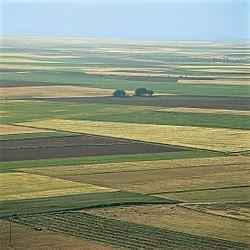Elevation 740 m (2,430 ft) | Municipalities ListSee text Time zone CET (UTC+1) | |
 | ||
Provinces | ||
Tierra de Campos ("Land of Fields") is a large historical and natural region or greater comarca that straddles the provinces of León, Zamora, Valladolid and Palencia, in Castile and León, Spain. It is a vast, desolate plain with practically no relief, except for some wide undulations of the terrain.
Contents
Map of Tierra de Campos, Spain
Originally it was known as "Gothic Plains" (Campi Gothici or Campi Gothorum), as the area had been settled by Visigoths who fled from Aquitaine Gaul after its conquest by the Franks. It was first mentioned under this name in Codex Vigilanus (Codex Albeldensis), and described as extending "from the river Douro, to the Christian Kingdom".
Despite the strong identity of its inhabitants, this historical region has not been able to achieve the necessary legal recognition for its administrative development. Therefore, its municipalities have resorted to organizing themselves in a mancomunidad, the only legal formula that has allowed the region to manage its public municipal resources meaningfully. Palencia is widely considered to be the capital of the Tierra de Campos.
Geography
"Tierra de Campos" is located on a fertile, elevated plateau with an average height of around 720 metres (2,360 ft), its geography is typical of the Meseta Central. The ground is mostly made up of quite compact clay. The climate is continental with long, cold winters and short, hot summers. Rivers naturally irrigating the area are sparse and traditionally the land in Tierra de Campos has been used for dryland farming. The Channel of Castile, which cuts across this comarca, was developed for transport purposes but developed into an irrigation system. Some of the wetlands in Tierra de Campos, like the Laguna de la Nava de Fuentes and the Lagunas de Villafáfila, are important for the ecology of the region. There are few natural forested areas left. The Tierra de Campos is the place with the highest concentration of bustard in the Iberian Peninsula, and possibly in the world.
There is no unanimous agreement regarding the precise boundaries of the Tierra de Campos. Since it is a natural and traditional region, no official limits have ever been assigned. One of the most widely accepted system of boundaries has been the following:
